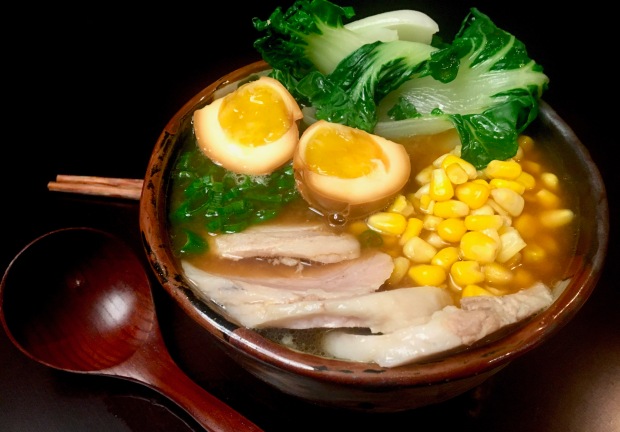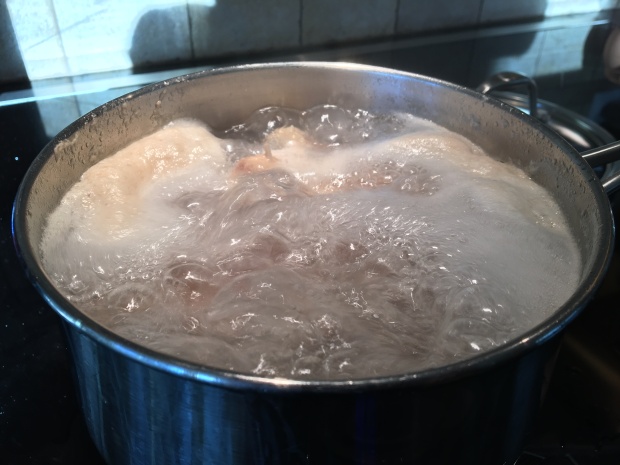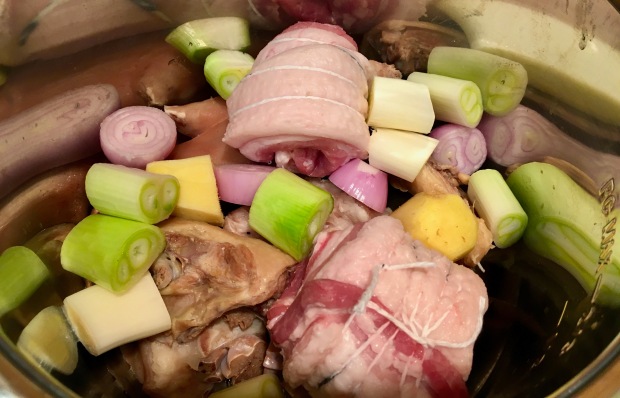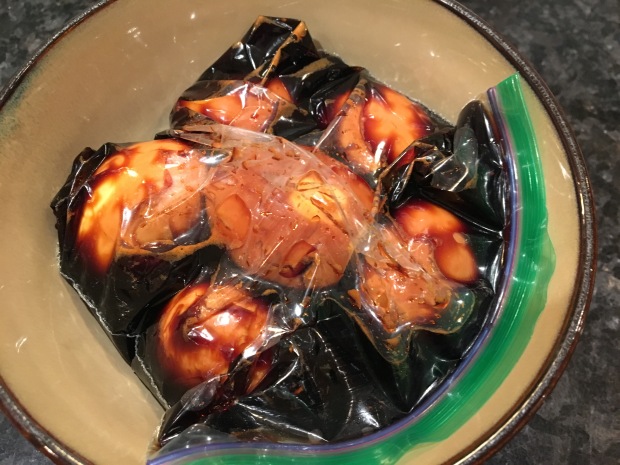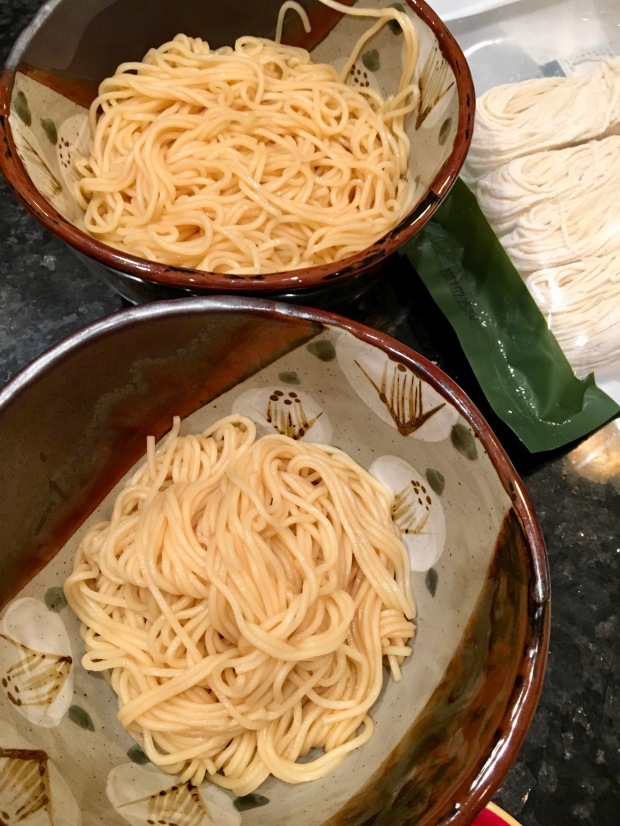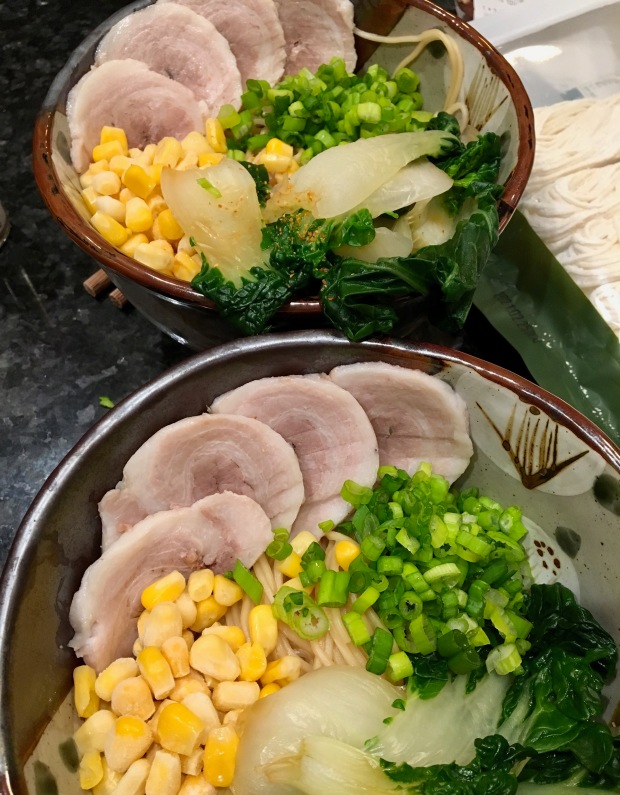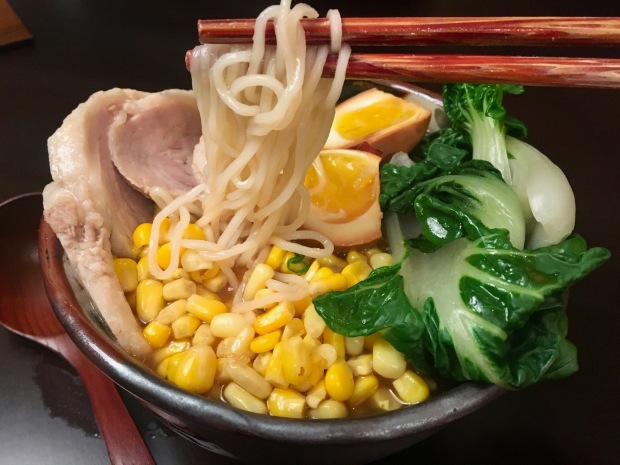
Spicy Eggplant with Ground Pork
Ingredients
- 2 eggplants (long eggplants, quartered length-wise and then cut in 5-7cm/2-3" pieces)
- 450 g ground pork (~1 lb)
- 1 Tbsp cornstarch
- 6 Tbsp vegetable oil
- 1 Tbsp sesame oil
- 3 garlic cloves (peeled and minced)
- 1 cm piece of ginger (peeled and julienned or shredded)
- 1 Tbsp anchovy paste
- 1 red bell pepper (cored and sliced thinly)
- 1 tsp shaoxing wine
- 1 tsp red wine vinegar
- 2 tsp soy sauce
- 1 Tbsp hot chili bean oil
- 1/2 cup water
- salt and white pepper (to taste)
- 4 green onions
Instructions
- Cut the eggplants into quarters length-wise, and then chop them into pieces, around 5-7cm/2-3" long. Core and slice the red pepper thinly. Peel and mince the garlic and ginger. Keep eggplant, pepper, and ginger and garlic separate.
- Cut the whites of the green onions away from the greens. Chop the whites into small pieces. Cut the green into 2cm pieces. Keep the whites and greens separate.
- In a medium bowl, mix the ground pork well with the cornstarch and a sprinkle of salt, and set aside.
- In a small bowl, mix the water, wine, vinegar, soy sauce, and chilli bean oil.
- Heat a wok or large frying pan on just below high heat and add 2 tablespoons of the of vegetable oil and 1/2 tablespoon of the sesame oil to the pan and heat until just smoking. Add half the eggplant, stirring constantly and cooking until some of the edges and sides have browned and the pieces have started to soften. Remove to a dish and repeat the process with the second half of the eggplant pieces and add the second set of eggplant pieces to the dish with the rest.
- Reduce the temperature to medium-high heat. In the empty wok, add remaining 2 Tbsps vegetable oil. Add garlic, ginger and whites of onions and cook until fragrant. Next, add the pork, and stir constantly until pork is mostly cooked, about 5 minutes. Add red peppers and anchovies and cook, stirring, for 1 minute.
- Add the liquid mixture and cook, stirring, until the liquid has fully coated everything and has started to thicken. Add the eggplant back into the wok with everything else and stir all together. Cook until eggplant is soft, but not falling apart. Add the greens of the onion and cook for another 30-60 seconds.
- Serve immediately with rice.
And now for the details…
Well hello friends. It has been a long time. Like… a really long time. I am so happy to be back with you and I apologize for the hiatus… but… life. *shrugs*

My return back on the scene comes with a dish that is a personal favourite. Delicate, velvety pieces of smoky eggplant, in a salty, umami-rich and slightly spicy sauce. Some strips of barely-cooked red pepper for sweetness and ground pork for both bite and to amp up the umami-ness? Heaven.
This dish is one of my favourites when we go for Peking duck as a side dish. Which is somewhat hilarious that we order it as a side, since it is quite hearty and is easily a meal all on its own. I did my best to recreate it at home with this recipe, but admittedly, it is not quite the same as the bubbling earthenware pot of deliciousness that comes to the table when we are out for dinner. However, when heading to the restaurant just isn’t a possibility, this is a great meal that comes together fairly quickly, and all it needs to wrap it all up is some steamed rice.
Let’s get to cooking, shall we? Now one of the biggest things for this that I found is that you really need to have everything ready BEFORE you start the actual cooking. The beauty of a wok is that things come together quite quickly, with the high temps and fast stir frying. But because of those high temps and the need to have almost constant attention on the food in the pan, there is little time to turn away from the stove and finish chopping that one last piece of veg, or grab that last ingredient from the pantry to mix into the sauce. That is my usual style in the kitchen… so I am definitely speaking from failed experience when I say that prepping and having everything ready first will mitigate burning, drying, or inconsistent cooking of the ingredients.
First first… if you are planning on having this with steamed rice… NOW is the time to get that rice in the cooker! The rest of the cooking process is going to be moving quick, so get the rice rinsed, in the cooker and hit the button now so it’s ready to go when the dish is done! (Am I speaking again from experience and needed to wait 20 minutes for the rice to be ready after the food was done? Maybe. *blushes slightly*)

So let’s prep. I like to get my aromatics prepped and set to the side first. Peel and mince your garlic, and set aside. You have a couple options for your ginger. You can either shred/mince it like you did the garlic, or you can julienne it into small pieces. The julienned ginger will introduce that occasional fruity, pungent hit of ginger in a bite of the finished product, while the shredded will meld more homogeneously throughout the dish, so chef’s choice depending on your taste preferences. For the green onions, you are going to separate the whites from the greens. The whites, you can chop finely and set aside with the ginger and garlic (those three will all be hitting the wok at the same time). The greens, you are going to cut into larger pieces, about 2-3 cm long.
For the eggplants, we are using a long eggplant, sometimes called a Chinese or Japanese eggplant, which is going to give us more surface area of the skin of the eggplant, and less seedy flesh. In a pinch, I have used a globe eggplant for this dish, and just cut it into chunks. It did work out, but had a slightly different result. To cut and prepare the long eggplants, I find it easiest to quarter them lengthwise down the centre into four long pieces, and then cut those into the long bits into smaller pieces about 5-7cm/2-3″ long.
The final step in our veg prep is the bell pepper. Core and quarter the pepper, then slice into long, thin-ish pieces. The pepper I used this time was fairly small, so if you have one of the giant monstrosities I have seen and purchased more recently in the grocery store, a half of a pepper is probably MORE than enough!

In a bowl, mix together the ground pork, cornstarch, and salt. This helps to preseason the meat slightly, and the cornstarch will help the pork crisp up slightly while cooking, and will also be a thickening agent for the sauce once it hits the pan.
Final step before heating up the wok and starting the fry up is to mix together the sauce. The shaoxing wine, red wine vinegar, soy sauce, chilli oil and water all get mixed into a small bowl and set aside. If you don’t have shaoxing wine in the pantry, cooking sherry is a decent replacement. But if you have a chance to pick up some shaoxing wine, I would highly encourage it. I hadn’t understood the missing element to so many Chinese recipes I would try until I came across a post about shaoxing wine on the Woks of Life. I hunted it down in my local asian grocery store and they were not kidding. The taste difference that it makes in those same recipes is mind blowing.
Let’s heat up that wok and get cooking! Heat up the wok to medium high heat. Add about 2 tablespoons of vegetable oil (canola, safflower, peanut, corn, or any vegetable oil with a high smoke point will all work here) and 1/2 tablespoon of sesame oil. Once the pan is heated up, and the oils are quite runny, add half the eggplant pieces to the pan. We want to cook them in batches, or else the pan will get crowded and we won’t get the right cook. Stir almost continuously, working to coat all the eggplant pieces with the oils, as well as to maintain a consistent cook through the pieces. Because the primary heat source is at the bottom of the wok, regularly stirring to give all the pieces a little love is important. The eggplant is ready to come out of the pan when it has softened slightly, and there is a light char on the edges of the vegetable. That little bit of char will give that slight smokiness we are looking for, and if we cook for too long, the eggplant will turn into a soggy mess. The flip side of that, though, is not cooking for long enough, which will result in chewy, slightly astringent piece of eggplant, so make sure they have softened, and are not still raw when you take them out. We will have a little more cooking time at the very end for the eggplant, so a slight undercook is better than way too soft. Set the cooked eggplant aside in a dish, then add another 2 tablespoons of vegetable oil and the last 1/2 tablespoon of sesame oil, and cook the second batch of eggplant. Once done, transfer into the same dish with the first batch of cooked eggplant.
Next, add the remaining 2 tablespoons of oil into the pan, and add your aromatics (the ginger, garlic and whites of the green onion). We are going to cook these quick, only until you can catch a good whiff of them cooking, around 30-60 seconds. Add the pork in with the aromatics, and cooking, stirring constantly. You may need to break down pieces if needed as you go; we are trying to keep the ground pork from cooking into large chunks. Continue until the meat is fully cooked through, I find this takes around 5 minutes.
Next, add the anchovy paste, mixing well into the pork, and then the red pepper pieces. Because the red pepper is so long and thin, you will need to be gentle as you stir it in to cook, so you do not break up the pieces too much. We are only cooking the red pepper for about a minute before moving on to the sauce. For the anchovy paste, if you have actual anchovies, and want to cut them into small pieces and add, this will totally work too. The traditional version of this dish uses Chinese salted fish. If you can get your hands on some of that, and rinse, chop, and add that instead, nice work! I bet your dish will taste AMAZING. For me, I have found that the fillets of salted fish are pretty huge for what I can find, and I never manage to use it all within an appropriate amount of time, so I go with the anchovy paste for ease of use.
We are almost at the finish line! Add the pre-mixed sauce in with the meat and red pepper, stirring well. With the cornstarch already in the pork, and the high heat of the wok, this should start to thicken fairly quickly. Once it starts to thicken, add the eggplant back in the dish (and any liquid that may have collected with the eggplant in its dish), stirring well to coat the eggplant with the sauce. Continue stirring and cooking until the eggplant is at just the right level of doneness for your preference. Add the greens of the onion, and stir, cooking for another 30-60 seconds, then immediately transfer to a serving dish. Time to eat! Serve with the steamed rice, and enjoy!

Happy eating.





















